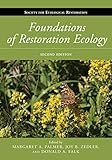Foundations of restoration ecology / edited by Margaret A. Palmer, Joy B. Zedler and Donald A. Falk
Palmer, Margaret A [editor] | Zedler, Joy B [editor/a] | Falk, Donald A [editor/a].
Tipo de material: Libro
impreso(a)
Series Editor: Washington, District of Columbia, United States: Island Press, c2016Edición: Second edition.Descripción: xxiii, 552 páginas : fotografías, gráf., ilustraciones, mapas ; 26 centímetros.ISBN: 1610916972; 9781610916974.Tema(s): Restauración ecológica
Libro
impreso(a)
Series Editor: Washington, District of Columbia, United States: Island Press, c2016Edición: Second edition.Descripción: xxiii, 552 páginas : fotografías, gráf., ilustraciones, mapas ; 26 centímetros.ISBN: 1610916972; 9781610916974.Tema(s): Restauración ecológica| Tipo de ítem | Biblioteca actual | Colección | Signatura | Estado | Fecha de vencimiento | Código de barras |
|---|---|---|---|---|---|---|
| Libros |
Biblioteca Tapachula
Texto colocado en la configuración de la biblioteca Tapachula |
Acervo General | 577 F6/2016 | Disponible | ECO020013697 |
Incluye bibliografía e índice: páginas 545-552
Foreword.. Preface.. Book Guide.. Acknowledgements.. PART I. Introduction to Restoration and Foundational Concepts.. Chapter 1. Ecological Theory and Restoration Ecology.. Chapter 2. Ecological Dynamics and Ecological Restoration.. Chapter 3. Biodiversity as a Goal and Driver of Restoration.. Chapter 4. Landscape Ecology and Restoration Processes.. PART II. Ecological Theory and the Restoration of Populations and Communities.. Chapter 5. Population and Ecological Genetics in Restoration Ecology.. Chapter 6. Ecophysiological Considerations for Restoration.. Chapter 7. Implications of Populations and Metapopulation Theory for Restoration Science and Practice.. Chapter 8. Invasive Species and Restoration Challenges.. Chapter 9. Assembly Theory for Restoring Ecosystem Structure and Functioning: Timing is Everything?.. Chapter 10. Heterogeneity Theory and Ecological Restoration.. Chapter 11. Food Web Theory and Ecological Restoration.. PART III. Ecosystem Processes and Restoration Ecology.. Chapter 12. Nutrient Dynamics as Determinants and Outcomes of Restoration.. Chapter 13. Recovery of Ecosystem Processes: Carbon and Energy Flows in Restored Wetlands, Grasslands and Forests.. Chapter 14. Watershed Processes as Drivers for Aquatic Ecosystem Restoration.. PART IV. The Spatial and Temporal Dimensions of Restoration.. Chapter 15. Evolutionary Restoration Ecology.. Chapter 16. Macroecology and the Theory of Island Biogeography: Abundant Utility for Applications in Restoration Ecology.. Chapter 17. The Influence of Climate Variability and Change on the Science and Practice of Restoration Ecology.. PART V. Synthesis and Challenges.. Chapter 18. Persistent and emerging themes in the linkage of theory to restoration practice.. About the Editors.. About the Contributors.. Index
The practice of ecological restoration, firmly grounded in the science of restoration ecology, provides governments, organizations, and landowners a means to halt degradation and restore function and resilience to ecosystems stressed by climate change and other pressures on the natural world. Foundational theory is a critical component of the underlying science, providing valuable insights into restoring ecological systems effectively and understanding why some efforts to restore systems can fail. In turn, on-the-ground restoration projects can help to guide and refine theory, advancing the field and providing new ideas and innovations for practical application. This new edition of Foundations of Restoration Ecology provides the latest emerging theories and ideas in the science of restoration ecology. Fully one-third longer than the first edition and comprehensive in scope, it has been dramatically updated to reflect new research. Included are new sections devoted to concepts critical to all restoration projects as well as restoration of specific ecosystem processes, including hydrology, nutrient dynamics, and carbon. Also new to this edition are case studies that describe real-life restoration scenarios in North and South America, Europe, and Australia. They highlight supporting theory for restoration application and other details important for assessing the degree of success of restoration projects in a variety of contexts. Lists at the end of each chapter summarize new theory introduced in that chapter and its practical application. Written by acclaimed researchers in the field, this book provides practitioners as well as graduate and undergraduate students with a solid grounding in the newest advances in ecological science and theory. eng
